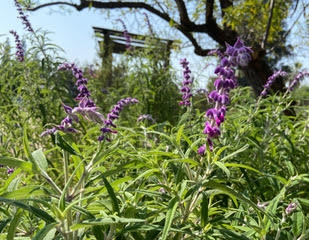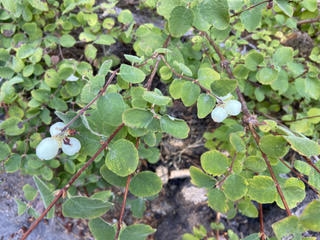Sep 28, 2023
Pick a bouquet of herbs in the early morning to retain flavor. Keep them in a vase and use them all week.
Tasks Hand pick snails the early morning. (All photos: Nancy Devaurs)
Hand pick snails the early morning. (All photos: Nancy Devaurs)
- Monitor soil moisture after rain and water if needed, especially for trees and shrubs.
- Renovate cool-season lawns – remove thatch and aerate.
- Hand pick snails and slugs in the early morning or use bait. Avoid baits that contain metaldehyde as they are toxic to all vertebrates.
- Monitor drainage after watering container plants to be sure plant roots are not standing
in water.
Pruning
- Sharpen your pruning tools in preparation for fall pruning.
Fertilizing
- Do not feed citrus and other frost-tender plants.
Planting
Fall planting continues
- Annuals: stock (Matthiola incan), forget-me-not (Myosotis), Iceland poppy (Papaver nudicaule), pansy, violet.
- Fruits and vegetable: Swiss chard, turnips, snow peas, plant from seed
- Perennials: Lupine (Lupinus), plant from seed.
- Trees, shrubs, vines: sago palm (Cycas), Ceanothus maritimus ‘Valley Violet', magnolia,
myrtle (Myrtus), flowering cherry (Prunus), oak (Quercus).
 Mexican bush sage is a member of the salvia family.
Mexican bush sage is a member of the salvia family.
Enjoy now
- Annuals and perennials: dianthus, aster (fall-blooming), Mexican blue sage (Salvia
leucantha), pansy (Viola). - Bulbs, corms, tubers: spider lily (Lycoris), Sternbergia lutea.
- Trees, shrubs, vines: Texas ranger (Leucophyllum), sweet orange (Osmanthus), cape plumbago, snowberry (Symphoricarpos).
- Fruits and vegetables: apples, bok choy, cantaloupe, persimmon, snap peas, tomatoes.
- Fall color: goldenrain tree (Koelreuteria).
Things to ponder
- Use organic mulch around permanent plants, and add organic matter into soil to prepare beds for spring planting.
- Spray hedges and shrubs with water to clean and keep them free of dust to discourage spider mites.
